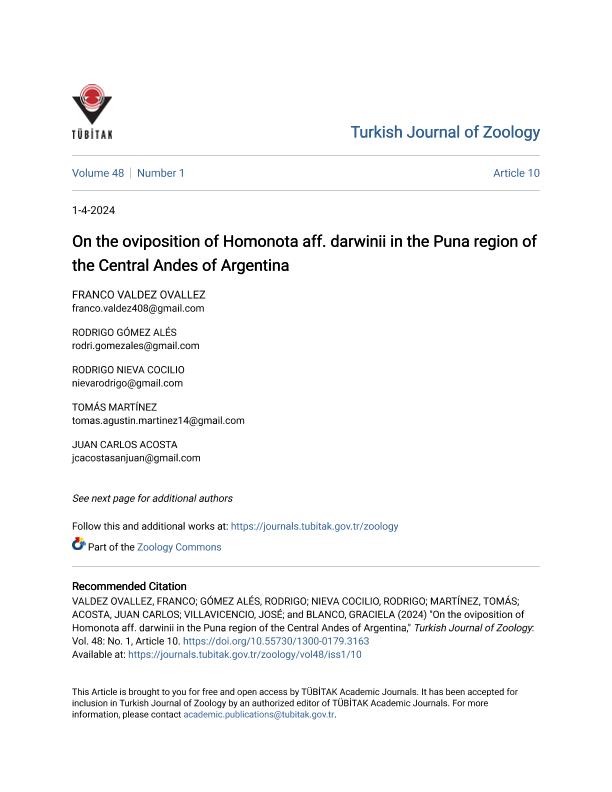Mostrar el registro sencillo del ítem
dc.contributor.author
Valdez Ovallez, Franco Miguel

dc.contributor.author
Gómez Alés, Carlos Rodrigo

dc.contributor.author
Nieva Cocilio, Rodrigo Alfredo

dc.contributor.author
Martínez, Tomás Agustín

dc.contributor.author
Acosta, Juan Carlos
dc.contributor.author
Villavicencio, José
dc.contributor.author
Blanco, Graciela
dc.date.available
2024-04-05T12:02:54Z
dc.date.issued
2024-01
dc.identifier.citation
Valdez Ovallez, Franco Miguel; Gómez Alés, Carlos Rodrigo; Nieva Cocilio, Rodrigo Alfredo; Martínez, Tomás Agustín; Acosta, Juan Carlos; et al.; On the oviposition of Homonota aff. darwinii in the Puna region of the Central Andes of Argentina; Tubitak Scientific & Technical Research Council Turkey; Turkish Journal Of Zoology; 48; 1; 1-2024; 98-103
dc.identifier.issn
1300-0179
dc.identifier.uri
http://hdl.handle.net/11336/232076
dc.description.abstract
Communal nest egg-laying refers to females laying their eggs with those of their conspecifics under or within artificial or natural structures. Homonota aff. darwinii is a recently discovered species that has not yet been formally described. The objective of this work is to characterise the oviposition of this species in the Puna region in the Central Andes of Argentina. We recorded the type and surface of the rocks where the eggs were laid, the temperature of the substrate, and the temperature of the rock surface facing the substrate. In addition, we recorded the daily temperature variation that a randomly selected potential spawning site would experience based on the characteristics of the rocks where the eggs were observed and the higher frequency of encounters with adult individuals. In January we found a nest with four hatched eggs under a rock. Later, in March we found two nests under two different rocks. One of the nests contained an unhatched egg, while the other nest contained an unhatched egg along with a hatched egg. Both unhatched eggs weighed 0.4 g and had a volume of 164.93 and 220.84 mm3. The embryo of one of the eggs was in an advanced stage of development, close to hatching. The rocks where the eggs were deposited were granitic and greyish. Each rock had a surface area of 768 and 1392 cm2, substrate temperature of 38.8 and 23.2 °C, and rock temperature of 35.5 and 24.9 °C, respectively. The potential nesting site registered a thermal amplitude of 15 °C (15–30 °C). It has been observed that H. darwinii in Patagonia has a one-egg clutch and an annual-biennial reproductive cycle, therefore, we hypothesize that the encounter of a nest with at least two unhatched eggs could indicate the occurrence of communal nests.
dc.format
application/pdf
dc.language.iso
eng
dc.publisher
Tubitak Scientific & Technical Research Council Turkey

dc.rights
info:eu-repo/semantics/openAccess
dc.rights.uri
https://creativecommons.org/licenses/by/2.5/ar/
dc.subject
EXTREME ENVIRONMENTS
dc.subject
GECKO
dc.subject
PHYLLODACTYLIDAE
dc.subject
REPRODUCTION
dc.subject.classification
Zoología, Ornitología, Entomología, Etología

dc.subject.classification
Ciencias Biológicas

dc.subject.classification
CIENCIAS NATURALES Y EXACTAS

dc.title
On the oviposition of Homonota aff. darwinii in the Puna region of the Central Andes of Argentina
dc.type
info:eu-repo/semantics/article
dc.type
info:ar-repo/semantics/artículo
dc.type
info:eu-repo/semantics/publishedVersion
dc.date.updated
2024-03-19T14:13:04Z
dc.identifier.eissn
1303-6114
dc.journal.volume
48
dc.journal.number
1
dc.journal.pagination
98-103
dc.journal.pais
Turquía

dc.description.fil
Fil: Valdez Ovallez, Franco Miguel. Consejo Nacional de Investigaciones Científicas y Técnicas. Centro Científico Tecnológico Conicet - San Juan; Argentina. Universidad Nacional de San Juan. Facultad de Ciencias Exactas Físicas y Naturales. Departamento de Biología; Argentina
dc.description.fil
Fil: Gómez Alés, Carlos Rodrigo. Consejo Nacional de Investigaciones Científicas y Técnicas. Centro Científico Tecnológico Conicet - San Juan; Argentina. Universidad Nacional de San Juan. Facultad de Ciencias Exactas Físicas y Naturales. Departamento de Biología; Argentina
dc.description.fil
Fil: Nieva Cocilio, Rodrigo Alfredo. Consejo Nacional de Investigaciones Científicas y Técnicas. Centro Científico Tecnológico Conicet - San Juan; Argentina. Universidad Nacional de San Juan. Facultad de Ciencias Exactas Físicas y Naturales. Departamento de Biología; Argentina
dc.description.fil
Fil: Martínez, Tomás Agustín. Consejo Nacional de Investigaciones Científicas y Técnicas. Centro Científico Tecnológico Conicet - San Juan; Argentina. Universidad Nacional de San Juan. Facultad de Ciencias Exactas Físicas y Naturales. Departamento de Biología; Argentina
dc.description.fil
Fil: Acosta, Juan Carlos. Universidad Nacional de San Juan. Facultad de Ciencias Exactas Físicas y Naturales. Departamento de Biología; Argentina
dc.description.fil
Fil: Villavicencio, José. Universidad Nacional de San Juan. Facultad de Ciencias Exactas Físicas y Naturales. Departamento de Biología; Argentina
dc.description.fil
Fil: Blanco, Graciela. Universidad Nacional de San Juan. Facultad de Ciencias Exactas Físicas y Naturales. Departamento de Biología; Argentina
dc.journal.title
Turkish Journal Of Zoology

dc.relation.alternativeid
info:eu-repo/semantics/altIdentifier/url/https://journals.tubitak.gov.tr/zoology/vol48/iss1/10/
dc.relation.alternativeid
info:eu-repo/semantics/altIdentifier/doi/https://doi.org/10.55730/1300-0179.3163
Archivos asociados
